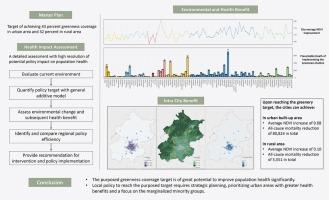中国98个城市绿色推广对死亡率的健康影响评价
IF 9.2
1区 环境科学与生态学
Q1 ECOLOGY
引用次数: 0
摘要
中国政府发布了《全国土地绿化规划纲要(2022-2030年)》,提出了城市绿化覆盖率43%、农村绿化覆盖率32%的目标。然而,地方政策实施的有效影响目标能否最大化仍不明朗。我们的研究旨在进行健康影响评估,以评估中国98个主要城市的纲要目标的潜力和有效性。应用广义加性模型将轮廓目标转化为1 × 1 km栅格尺度上可测量的归一化植被指数(NDVI)。基于估算的绿地目标和遥感影像,我们估算了NDVI的改善潜力和相应的年度可预防死亡人数。此外,我们评估并比较了不同地区绿色推广的有效性。我们发现,实现大纲目标有可能每年预防86,375例(95% CI: 78,279, 94,542)例死亡,占总死亡率的1.78%。该指标的健康效益主要体现在城市地区和大城市。华东和华北地区显示出最大的健康效益,上海(6,809,95%置信区间:6,083,7,538)、天津(5,496,95%置信区间:5,163,5,830)和北京(4,238,95%置信区间:4,062,4,413)等特大城市的可预防死亡率最高。城市地区的NDVI较低,人口密度较高,与农村地区相比,可预防的死亡人数更多。健康影响分析结果强调需要战略性绿色发展,优先考虑城市地区和弱势群体在获得绿色和健康差异方面的潜在不平等。调查结果为决策者和利益攸关方提供了以证据为基础的建议,以促进健康和可持续发展。本文章由计算机程序翻译,如有差异,请以英文原文为准。

Health impact assessment of greenness promotion on mortality in 98 cities in China
The China government issued the National Land Greening Plan Outline (2022–2030), which set a greenness coverage target of 43 % in urban area and 32 % in rural area. However, the implementation of local policies to effectively maximize the impact of the target remains unclear. Our study aims to conduct a health impact assessment to evaluate the potential and effectiveness of the outline target in 98 major Chinese cities. Generalized additive model was applied to translate the outline target into measurable Normalized Difference Vegetation Index (NDVI) at a 1 × 1 km grid scale. Based on the estimated target and remote sensing imagery on green space, we estimated the potential of NDVI improvement and corresponding annual preventable deaths. Additionally, we evaluated and compared the effectiveness of greenness promotion across different regions. We found that achieving the outline target has the potential of preventing 86,375 (95 % CI: 78,279, 94,542) deaths annually, accounting for 1.78 % of the total mortality. The health benefits of the target are mainly observed in urban areas and larger cities. East and North China show the greatest health benefits, with the highest preventable deaths in megacities like Shanghai (6,809, 95 % CI: 6,083, 7,538), Tianjin (5,496, 95 % CI: 5,163, 5,830), and Beijing (4,238, 95 % CI: 4,062, 4,413). Urban areas have lower NDVI and higher population densities, leading to more preventable deaths compared to rural areas. The health impact analysis results underscore the need for strategic greenness development, prioritizing urban areas and vulnerable populations considering potential inequities in greenness access and health disparities. The findings provide evidence-based recommendations for policymakers and stakeholders to promote healthy and sustainable development.
求助全文
通过发布文献求助,成功后即可免费获取论文全文。
去求助
来源期刊

Landscape and Urban Planning
环境科学-生态学
CiteScore
15.20
自引率
6.60%
发文量
232
审稿时长
6 months
期刊介绍:
Landscape and Urban Planning is an international journal that aims to enhance our understanding of landscapes and promote sustainable solutions for landscape change. The journal focuses on landscapes as complex social-ecological systems that encompass various spatial and temporal dimensions. These landscapes possess aesthetic, natural, and cultural qualities that are valued by individuals in different ways, leading to actions that alter the landscape. With increasing urbanization and the need for ecological and cultural sensitivity at various scales, a multidisciplinary approach is necessary to comprehend and align social and ecological values for landscape sustainability. The journal believes that combining landscape science with planning and design can yield positive outcomes for both people and nature.
 求助内容:
求助内容: 应助结果提醒方式:
应助结果提醒方式:


